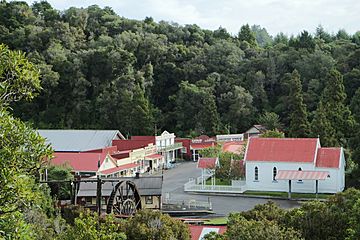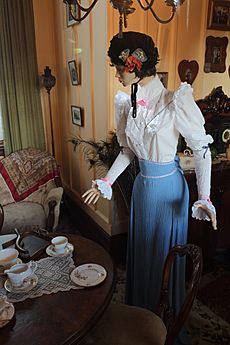Shantytown Heritage Park facts for kids
Shantytown Heritage Park, often called just Shantytown, is a fun place to visit in the West Coast Region of New Zealand's South Island. It's about 10 kilometers south of Greymouth. This special park opened in 1971 and looks like a gold-mining town from the 1800s. It has 30 old buildings that have been rebuilt or moved there. Shantytown is surrounded by beautiful native forest and is one of the most popular spots in the area.
Contents
History of Shantytown
Shantytown was created because people in Greymouth wanted to save the history of gold mining on the West Coast. A group of local people started the West Coast Historical and Mechanical Society in 1968. Shantytown Heritage Park first opened its doors to visitors on January 23, 1971. Many volunteers helped build and set up the park, giving their time and effort. Over the years, people and businesses in the area have donated thousands of old items. These include gold-mining tools, furniture from early settlers, everyday objects, clothes, and old photos.
The park and its collection mostly show what life was like during the Victorian era, from the mid-1800s up to just before World War I. Some items even go as far as the 1940s. Many of these historical items are displayed inside the buildings, making them look just like they did long ago. More delicate items are kept safe in special storage because the West Coast weather can be damp. Today, a local group still looks after Shantytown Heritage Park, and the community continues to be very involved.
What to See and Do at Shantytown
Shantytown has two main streets with 30 historic buildings. You can explore a church and a two-story hall called the Coronation Hall. Most of these buildings are real old structures that were moved or rebuilt here. They now look like shops from the late 1800s, such as a bank, a hotel, a butcher, a shoe shop, a barber, a carpenter, and a blacksmith. Some shops even sell old-fashioned sweets! There's also a hospital, a train station, a fire station, a Masonic Lodge, and a jail.
Crafts and Trades
At the foundry, you can see how people used to work with iron. There are interactive displays and old equipment that show the skills and tools used for ironwork a long time ago.
Chinatown Experience
Next to the main town, there's a "Chinatown" area. This part shows what life was like for Chinese gold miners. Many Chinese immigrants came to the West Coast in the 1860s. They came from other gold fields in New Zealand when the gold ran out, or directly from China.
Ride the Old Train
Shantytown also has a re-created narrow-gauge train line. This "bush tram" follows an old sawmill track from the Shantytown train station. It goes to a stop at the Infants Creek Sawmill and then to a final stop about 1.5 kilometers away, which is great for photos. The trains run all day, and your ticket includes the ride. The train station is a smaller copy of original railway plans. You can get off at Infants Creek Sawmill, where they fire up a sluice gun up to four times a day. You can also try your hand at gold panning with help from an expert! The old passenger carriages are pulled by either "Gertie," an 1877 steam engine from England, or by the 1896 "Kaitangata" steam engine.
More Fun Activities
You can take an "old time" photo dressed in costumes from the past. There's also a special show in a holographic theatre and a playground for younger visitors. Short walks through the bush nearby lead to a monument and a lookout point with great views.
The town's church, built in 1866, is open to all faiths and can be booked for weddings. There's also an education center, supported by the New Zealand Ministry of Education, which offers hands-on history lessons for school groups.
Shantytown has a cafe and a souvenir shop. It's open every day of the year, except for Christmas Day.
Famous Locomotives
Shantytown is home to several historic locomotives, each with its own story.
- Kaitangata (or Katie) was built in Scotland in 1896. This steam engine was used on an 8-kilometer railway line that carried coal from a mine in Kaitangata, New Zealand to the main railway. After the mine railway closed in 1970, Kaitangata was given to Shantytown in 1971.
- PWD 508 (nicknamed Gertie) is an L-class steam engine built in England in 1877. It was one of ten such engines made for the New Zealand Railways. Gertie worked on many construction projects in the North Island between 1903 and 1931. Later, it was used by a cement company until 1964. After being displayed at another historic village, Shantytown bought Gertie with a special grant. After a full repair, it started working again in 2002.
- A Climax engine, built in Pennsylvania in 1912, was used in New Zealand's logging industry. It helped move timber for sawmills in the central North Island. After many years of hard work, it was bought by a private owner and later leased to Shantytown in 1971. It was fully restored and started running in 1980.
- The Opossum is a very special locomotive because it's one of the oldest complete New Zealand-built engines, made in 1875. It worked for various companies, including the Greymouth Harbour Board. After being displayed in Greymouth for many years, it was donated to Shantytown in 1986. It was restored and put on display in 2012.
- A Heisler geared locomotive, built in 1924, is one of the few left from this manufacturer. It worked for sawmills in the West Coast region. Shantytown bought it in 1969, and after restoration, it was put on display in 2012.
- TR 107 (also known as TR 396 and Rosie) is a diesel locomotive built in 1957. It worked for the New Zealand Railways for many years. Shantytown bought it in 2005. After being restored in 2008, it now wears a green paint job and is named "Rosie."
- The Nattrass is a unique rail tractor from 1936. It was a modified Fordson farm tractor. This invention helped sawmills reach new areas that horses couldn't get to, making it easier to transport timber.
See also
- West Coast Historical and Mechanical Society




